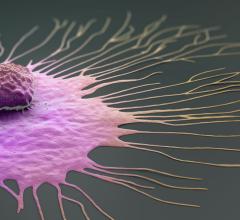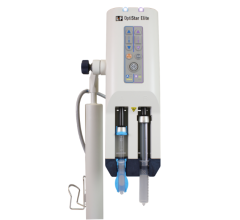
March 31, 2009 – Lantheus Medical Imaging Inc. reported that its novel fluorine 18-labeled positron emission tomography (PET) tracer for myocardial perfusion imaging in subjects under rest and stress conditions is well-tolerated and demonstrates radiation dosimetry that is comparable to or less than that of other PET agents, according to Phase I data on the safety and tolerability of BMS747158 presented at ACC09.
Principal Investigator, Jamshid Maddahi, M.D., F.A.C.C., professor of molecular and medical pharmacology (Nuclear Medicine) and medicine (Cardiology) at the David Geffen School of Medicine at UCLA and principal investigator of the study. presented the poster (abstract number 1054-263) said the data also showed high myocardial uptake at rest that significantly increases with pharmacologically induced stress and a ratio of myocardial to background radioactivity that is favorable and improved over time. These findings suggest that BMS747158 has strong potential as a myocardial perfusion PET imaging agent for patients both at rest and under stress.
“These data raise hope that BMS747158 could help address the need for a radiopharmaceutical that provides greater accuracy and broadens the applicability of PET technology for myocardial perfusion imaging,” said Dr. Maddahi. “These studies found that the mean effective dose of BMS747158 was very similar to that of a commonly used F-18 labeled agent, FDG, but the radiation level absorbed by the organ receiving the highest dose was significantly lower with BMS 747158.”
The Phase I clinical trials were designed to evaluate human safety, dosimetry (the dose of radiation absorbed by the body), biodistribution and myocardial imaging characteristics of BMS747158 in healthy subjects under rest and stress conditions. Thirteen subjects were injected with 222 MBq intravenously at rest in one study. In a second Phase I study, twelve additional subjects received 93 MBq BMS747158 intravenously at rest and 127 MBq under stress (either induced pharmacologically using adenosine infusion or using exercise on a treadmill) the following day. Imaging of the heart using PET technology was conducted for 10 minutes, followed by sequential cardiac and whole body imaging. Extensive safety monitoring was conducted with physical exams, clinical lab testing, ECG, EEG, blood chemistry and vital signs assessments before and after the injections.
Preliminary results of these Phase I studies show that no adverse events attributed to BMS747158 were reported. Preliminary results also show that the mean effective dose (ED, a relative measure of the long-term risk due to radiation exposure) was estimated to be 0.019 mSv/MBq at rest and pharmacological stress and 0.015 mSv/MBq under exercise stress. While the ED of BMS747158 was very similar to the ED for FDG, a commonly used F-18 labeled PET imaging agent, the dose to the organ receiving the highest dose was lower by a factor of 2.5 at rest and 1.8 under stress. Preliminary biodistribution results showed high myocardial uptake at rest that increased significantly with adenosine-induced stress. The ratio of myocardial to liver radioactivity reached a maximum of approximately 1, 2 and 5 at 20 minutes following injection for rest, pharmacological stress and exercise stress respectively and was stable (for exercise stress) or improved markedly thereafter.
“These studies found that BMS747158 has high myocardial uptake among patients at rest and under stress, which points to its potential in PET myocardial perfusion PET imaging. Combined with the findings that BMS747158 is well-tolerated in the studied population, these are very encouraging data that we will aim to replicate in additional broader studies,” said D. Scott Edwards, Ph.D., vice president, Global R&D, Lantheus Medical Imaging, Inc. “Lantheus is committed to developing innovative imaging agents that provide physicians with improved options for diagnosing and managing their patients.”
Findings of preclinical studies describing this novel agent’s promise for use in combination with PET imaging were published in The Journal of Nuclear Cardiology (JNC) and The Journal of Nuclear Medicine (JNM).
For more information, visit www.lantheus.com


 October 09, 2025
October 09, 2025 









